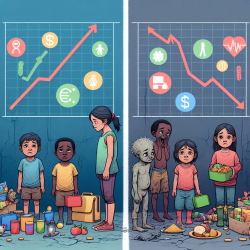Introduction
As practitioners dedicated to improving children's well-being, understanding the factors that influence life satisfaction (LS) and self-perceived health (SPH) is crucial. The CASPIAN IV study provides valuable insights into how socioeconomic status (SES) affects these outcomes in Iranian children and adolescents. By analyzing this data, we can develop strategies to mitigate these disparities and enhance children's health and happiness.
The CASPIAN IV Study: Key Findings
The CASPIAN IV study, conducted between 2011 and 2012, examined 14,880 students aged 6–18 years across Iran. It assessed the impact of SES on LS and SPH using various indices. The results revealed significant disparities in LS and SPH across different SES quintiles:
- Life satisfaction increased from 73.28% in the lowest SES quintile to 86.57% in the highest.
- Self-perceived health improved from 76.18% in the lowest SES quintile to 83.39% in the highest.
These findings highlight the inequality favoring higher SES groups, suggesting that socioeconomic factors play a critical role in children's health and well-being.
Implications for Practitioners
Understanding these disparities allows practitioners to tailor interventions that address the root causes of inequality. Here are some strategies to consider:
- Focus on Environmental Factors: The study identified living area and passive smoking as significant contributors to SES inequality. Practitioners can advocate for smoke-free environments and community programs that promote healthy living conditions.
- Encourage Physical Activity: Physical activity was linked to better SPH outcomes. Schools and community centers can provide accessible sports and exercise programs to all children, regardless of their SES.
- Supportive Family Structures: Family dynamics, such as living with both parents, were associated with better LS and SPH. Practitioners can work with families to strengthen relationships and provide resources for single-parent households.
Encouraging Further Research
The CASPIAN IV study underscores the need for further research into the specific mechanisms linking SES to children's health outcomes. Practitioners are encouraged to explore these relationships in their contexts and contribute to the growing body of knowledge. By doing so, we can develop more effective interventions and policies that promote equity in children's health and well-being.
Conclusion
The CASPIAN IV study provides compelling evidence of the impact of SES on children's life satisfaction and self-perceived health. As practitioners, we have the opportunity to use this data to inform our practices and advocate for policies that address these disparities. By focusing on environmental factors, promoting physical activity, and supporting family structures, we can create a healthier, more equitable future for all children.
To read the original research paper, please follow this link: Economic Inequality in Life Satisfaction and Self-perceived Health in Iranian Children and Adolescents: The CASPIAN IV Study.










